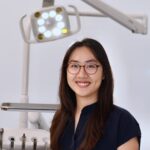Student Profile: Amy Yu Xuan Lin (DDS 2025) – Navigating dental school and the equestrian show-jumping arena15 min read
Now in her fourth and final year on the way to her Doctor of Dental Surgery degree next spring, Amy Yu Xuan Lin is feeling confident in her dentistry skills.
She’s steadily completing the checklist of required patient treatments during appointments in the University of Michigan School of Dentistry clinics. She’s also been on the road in recent weeks to finish the school’s required external rotations at various clinics around the state of Michigan, most recently for two weeks in Atlanta, Michigan, a rural area in the far northeast corner of the Lower Peninsula.
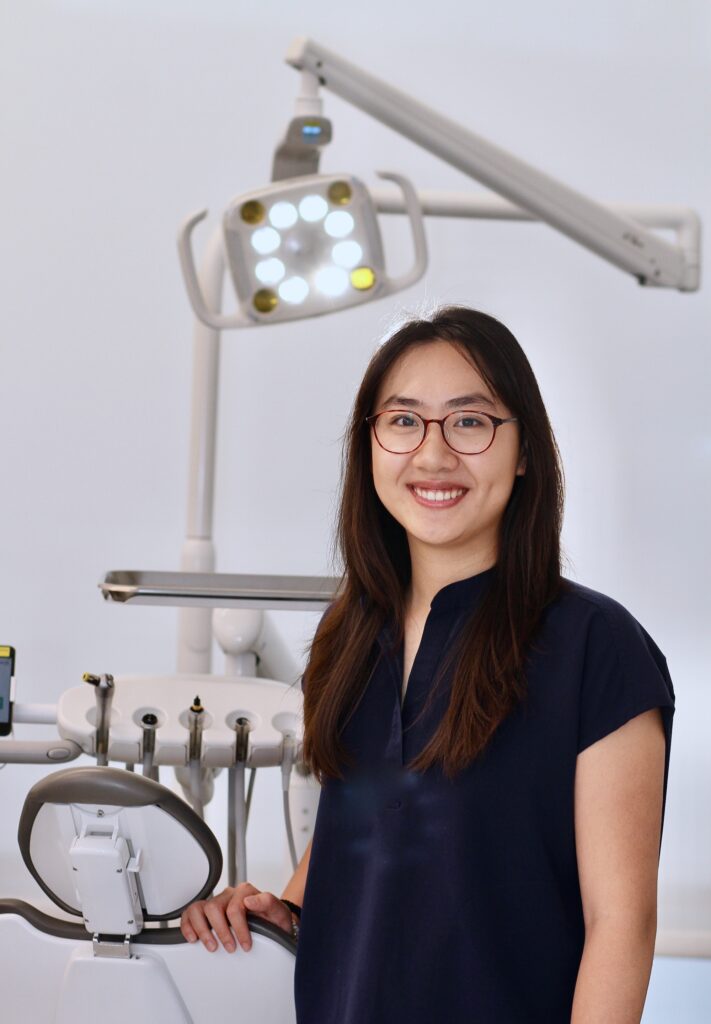
While there is much to complete before graduation next May, Lin’s journey so far has already been a bit more far-reaching than most of the students at the dental school. She was born in Beijing, China, and lived there through high school, except for three years during her elementary school years when her family lived in Canada. For college, she decided she wanted to study in the U.S. and scouted for small colleges where she would feel comfortable. She chose Carleton College in Northfield, Minnesota, majoring in biology and bio-chemistry as a pre-dentistry curriculum.
Lin considered careers in science and healthcare. Her mother is an orthodontist in Beijing so dentistry was an obvious option, but she also weighed medicine. Ultimately, she chose dentistry because of her familiarity with it through her mother’s practice and because medical doctors are often affiliated with a hospital, a tie that can reduce the flexibility for moving to new locations. She likes working with her hands and she wants to have options for where she will practice in the future, so preparing for dentistry became her focus at Carleton.
When it came to applying to dental schools, the University of Michigan was a lofty aspiration because of its standing as one of the top schools in the country and the world. “I decided it’s not going to hurt if I apply,” she said. “After Carleton, I was used to the Midwest. I like the people here. The winter weather didn’t really bother me that much. I thought it would be nice to stay in this area. I really liked my interview here. I felt like the questions they asked were very different from some of my other interviews; they required a bit more thinking. When I got the call that I was accepted, I was in China and it was the middle of the night. I was so excited that I then proceeded to wake up everyone in the house with the news.”
A Covid start
Lin and the rest of the DDS Class of 2025 arrived in the summer of 2021 during the second-year of the Covid-19 pandemic, when health protocols and restrictions were still changing the normal routine of the school. At the start, nearly all of their classes were online rather than in-person. As is always the case, the first two years of dental school are a heavy load of classroom academics that challenge even the best students. Adding in the Covid elements made it more challenging, but Lin says a positive was that it contributed to a tighter bond among the class members who developed study groups and other ways of making connections.
“It is a lot of struggling through everything together,” Lin said. “You spend every day together, so you make really tight friendships. When you first come in, the school throws a lot at you. It makes it so much easier when you are all in it together. It is nice to have friends.”
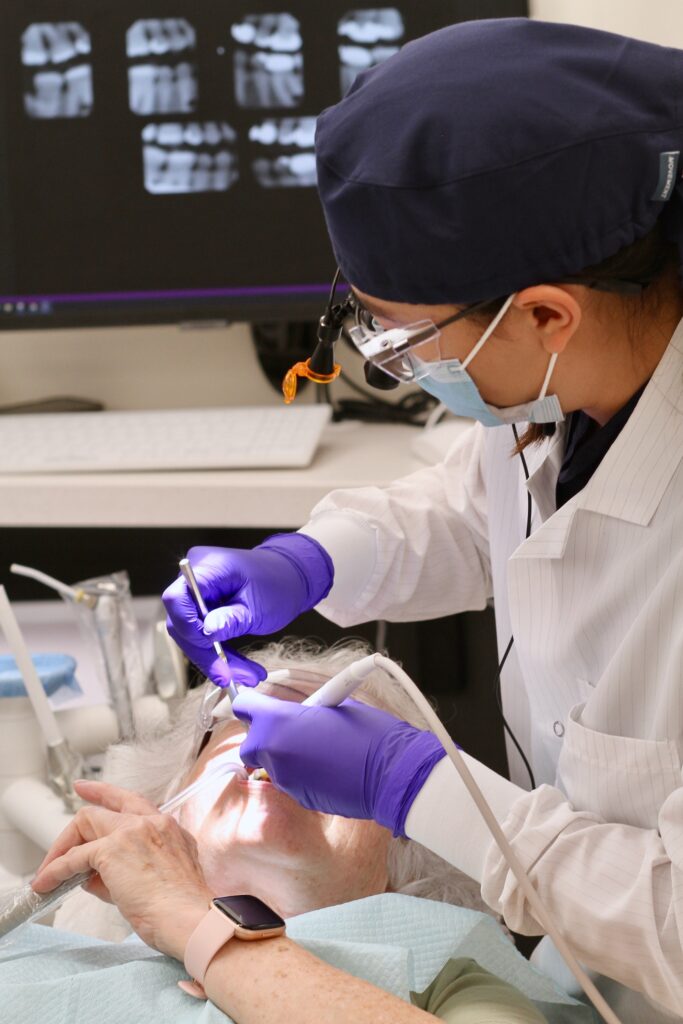
Once the first two years were finished, the third and fourth years have been more focused on hands-on treatment of patients in clinic and less on classroom learning. “This fourth year is a lot more comfortable than the other years,” Lin said. “You are really hitting your stride and developing your own skills as a clinician. But you also have the support of faculty in the clinic so you can turn to someone if you have questions. During first and second year, the treadmill was going so fast and you couldn’t get off. Then third year was a sudden change of pace and it was interesting to apply everything we had learned. And fourth year it is getting more comfortable.”
An important part of Lin’s dental school experience, helping fulfill her longstanding interest in science, has been working in the lab of faculty member Dr. Darnell Kaigler, Jr. Starting in her first year and still now in her fourth year, Lin has conducted research on various aspects of Kaigler’s focus on regenerating and engineering oral and maxillofacial tissues. She helped explore new methods for growing more stem cells in shorter amounts of time with less handling. At the school’s annual Research Day in February, Lin was awarded 3rd place in the category of Basic Science Research and Translational Research for DDS, Dental Hygiene, Masters and undergraduate students. Her research poster from Kaigler’s lab detailed a “Clinically Acceptable System for Expansion of Dental Pulp Derived Stem Cells.”
“I have a lot of fun in lab,” she says. “It’s a different group of people from the school and getting a glimpse into that research is part of what makes Michigan Dentistry so strong and interesting.”
An accomplished equestrienne
Last year, as Lin began the third year of dental school, she had settled nicely into the academic routine. Classes and grades were going well, she liked dental school, she had made friends, and she was looking ahead to what upper classmen had said is a much easier third year compared to the first two. She decided it was time to return to her love of horses and equestrian competition.
In her hometown of Beijing, she began equestrian training in middle school and continued through high school. Her family lived near a training facility and she steadily became an accomplished rider with her horse named Vocarlos. They were part of a small, tight-knit group that included national-level riders who were part of China’s growing interest in equestrian competitions that lead to the Olympics.

Lin competed in the jumping discipline in which riders direct their horses around a course that requires jumps over obstacles. It is a timed event with penalties if an obstacle is knocked down or the horse refuses to jump. She and Vocarlos advanced into higher levels of competition, winning awards at various shows. Her favorite show-jumping experience was when they competed in a major international show, the Longines Equestrian Beijing Masters. It was held at the National Stadium built for the 2008 Olympic Games, a venue recognized around the world for its striking architecture that resembles a bird’s nest.
By the time Lin was about to finish high school, she had an important decision to make: Should she pursue her plan for higher education degrees in the U.S. or should she join with her talented equestrian friends on the professional circuit in Europe in order to advance to highest levels of the sport. She chose education in the U.S.; some of her friends became members of the Chinese Olympic equestrian team.
With that high level of equestrian achievement as a backdrop, Lin came to the U.S. to begin her undergraduate degree at Carleton College. She was without a horse for the first time in many years. It started a period of six years – four at Carleton and her first two at the dental school – when she basically dropped out of the equestrian life. Her family still owns Vocarlos, but she could rarely travel back to China to see him during the school year. During the pandemic, China’s two-week quarantine for incoming travelers further reduced her opportunities to return home during school breaks.
Then last year, with the most demanding two years of dental school out of the way, Lin decided she would have the time and commitment to re-enter the relatively small universe of people who love horses enough to embrace the demanding amount of time and work they require. It would also be a healthy diversion from thinking non-stop about dental school. At first, she hoped to find a horse with advanced skills like Vocarlos so she could return to the level of show-jumping performance she had achieved in China. Finding a horse like that for lessons or to lease proved difficult. She compromised. “In the end, it turned out that I realized: I think I just need to get a horse.”
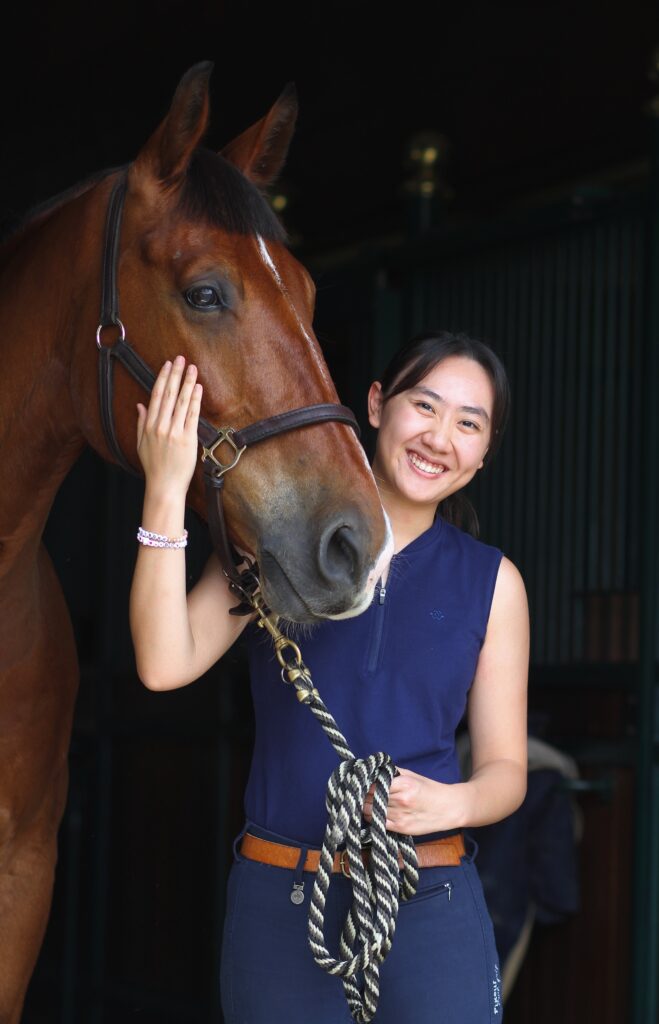
His name is Oklahoma, but she calls him Oakley. He is a Belgian Warmblood with a beautiful, deep brown coat and a “very sweet, very safe” personality. She boards him at an equestrian center near Saline that is a 25-minute drive from the dental school. Oakley isn’t as advanced at show-jumping as Vocarlos, but Lin has already competed with him twice and will participate in a third show in late August. “Training-wise he is well-trained, he knows what he is doing,” Lin said. “It’s just a matter of maintaining his athleticism, making sure we are on the same page.” She takes lessons with him in a large arena that is part of the facility where he is boarded.
“It is a lot of commitment. It was kind of scary for me to do,” Lin says of her decision to return to the equestrian life with two years of dental school left, including external rotation requirements where she is treating patients at clinics elsewhere around Michigan for a week or two at a time.
Lin visits Oakley every Saturday and Sunday, plus a couple of evenings during the week after she finishes her patient appointments at the dental school. The equestrian center staff takes care of him the rest of the week and when she is away for dental school rotations.
In China, her horse was tended by grooms and trainers who met every need. “There, if I was gone for two weeks, I didn’t need to worry about a thing. We had grooms that would take care of the horses. Here, it more like you are on your own. I’m the groom. I have to manage everything. I have to see when the farrier is coming in, when Oakley needs his vaccinations, when he needs to see the dentist – he does have one. And when he needs to see the vet. It’s a lot more managing on my part. Whereas back home, I had this whole team of people whom I had grown up with that I trusted and they could manage things.”
Mixing Oakley with dental school takes planning. She tries to finish her patient appointments by 4:30 in the afternoon if she is going to the barn that evening. “Depending on if he rolled in the mud that day, it takes me anywhere from a half hour to an hour to get him tacked up. And then I ride for an hour. And then another 45 minutes to get him cleaned up and showered. By the time I get home it’s 8:30 or 9 and I haven’t even eaten yet.”
The tradeoff is worth the effort. “When I’m out there it is a whole different world,” she says of the rural area around the equestrian center. “It’s just pastures. No one from dental school is there. It’s just me and Oakley. It’s nice to have that balance.”
Finishing the degree(s)
Lin wants to continue her equestrian avocation and compete at a higher level of show-jumping if she can find the time to train and enter shows at major equestrian venues. “Michigan is actually a great location to do all of this,” she said. “Traverse City hosts a very high-level circuit of shows in the summer that attracts high-level riders from all over the country, and we are also close to the World Equestrian Center in Ohio. Doing some shows at these places are my next goals with Oakley.”
At the same time, she knows that her dental career has to be her main focus at the moment. Not only is she approaching her DDS degree in the spring, but she is also planning to continue on for a graduate degree in the specialty of periodontics.
As she started dental school, she wasn’t particularly interested in periodontics. She knew it was about the prevention and treatment of the chronic inflammatory disease that affects the gums and bone that supports teeth. “Coming into dental school, I thought perio was just fancy cleanings,” she said. “But going up to the grad perio clinic and being able to assist on some very interesting and very complicated procedures has been very eye-opening.”
Lin also discovered scaling and root planing, a deep cleaning procedure for teeth and their roots that she found highly satisfying. “You are there with your scalers, kind of by yourself, scaling away. It is very peaceful. Cleaning teeth is one of the first things you learn, one of the first procedures you do. You can get really complex with it. With perio patients, you really get in there because those pockets are really deep. You see improvement when the patients return and it is so satisfying because you are really helping them maintain their whole dentition. You are changing their habits at home and improving their systemic health. Overall you see a change in their whole mouth, instead of doing a single filling that they can’t even see in the back of their mouth.”
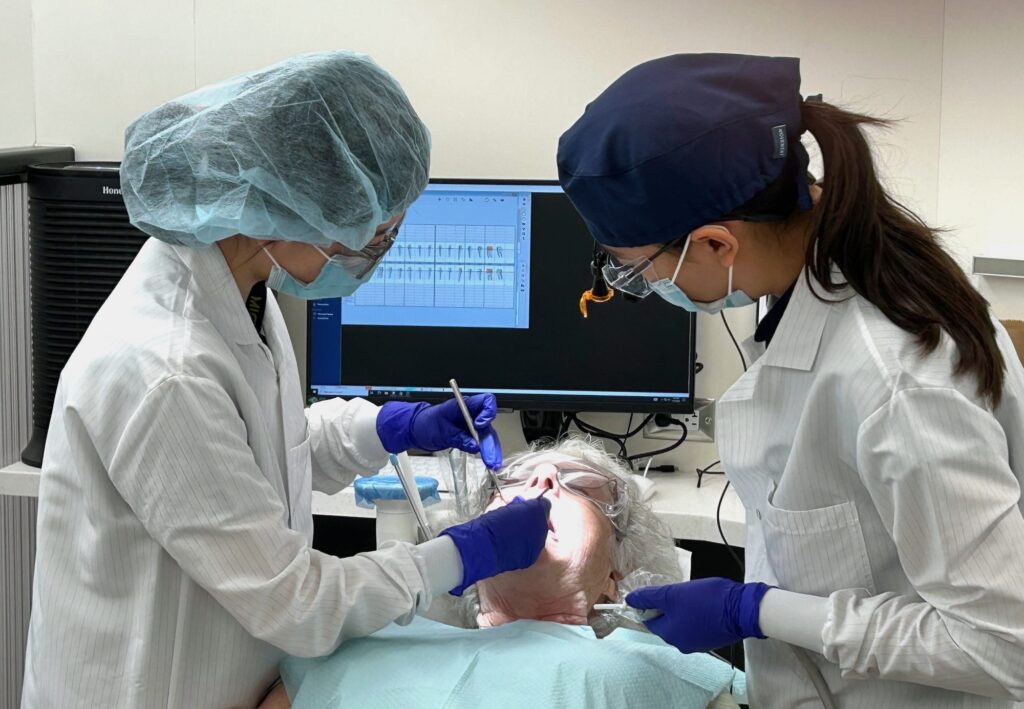
“I decided I love doing this so I want to do this for my career. Being able to see the research side of it also, where this field is going in the future, that was very interesting to me.” It meshed nicely with the Kaigler Lab research on tissue and bone regeneration to help patients heal after oral surgery, dental implants and other procedures.
Lin has applied to several perio graduate programs, including the one a couple of floors above where she treats patients now at U-M. She says she would be “very, very happy” to stay in Ann Arbor for that three-year graduate program leading to an MS degree.
She is also happy with her decision to go into dentistry and the progress she continues to make in her final year at the dental school. “I think the more you learn about it and the better you get at it, the more interested you become. The more competent you become, the more happy you are and the more excited you are to be doing these things. That’s really at full speed right now. I’m getting better at it because we have so much time in clinic. I’m not doubting myself as much anymore, so it’s getting to be very enjoyable.”
She hopes to be a practicing clinical periodontist. She said she will likely return to China to practice and to be close to her parents in later life as a way to thank them for their sacrifices and support to this point.
Regardless of whether patients are here or in China, Lin said the problems and solutions are the same – as is the gratification for the dentist.
“You see patients who are in pain, or aren’t happy with the way their smile looks, and after a couple of appointments, you can make really big changes. Especially with denture patients, you are changing their lives. There are people who haven’t had teeth for years and then all of a sudden they have a smile and can chew and eat again. You feel very fulfilled because they are so happy with it.”
###
The University of Michigan School of Dentistry is one of the nation’s leading dental schools engaged in oral healthcare education, research, patient care and community service. General dental care clinics and specialty clinics providing advanced treatment enable the school to offer dental services and programs to patients throughout Michigan. Classroom and clinic instruction prepare future dentists, dental specialists and dental hygienists for practice in private offices, hospitals, academia and public agencies. Research seeks to discover and apply new knowledge that can help patients worldwide. For more information about the School of Dentistry, visit us on the Web at: www.dent.umich.edu. Contact: Lynn Monson, associate director of communications, at [email protected], or (734) 615-1971.

